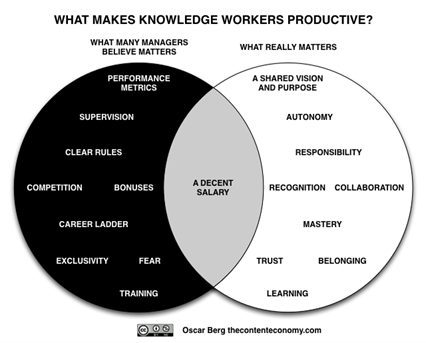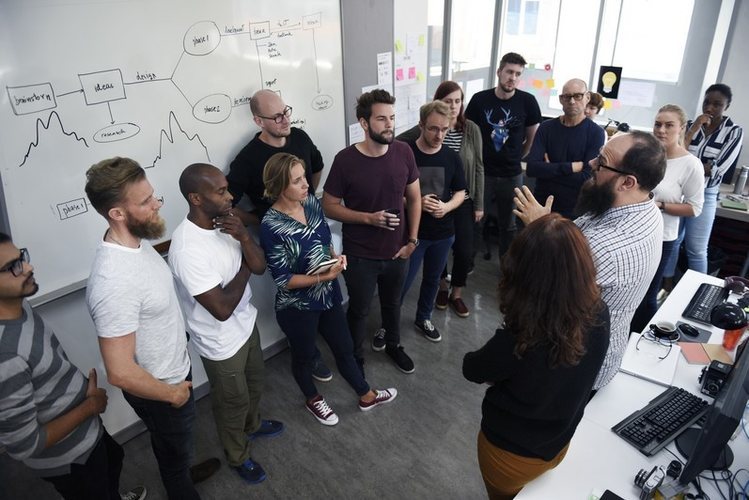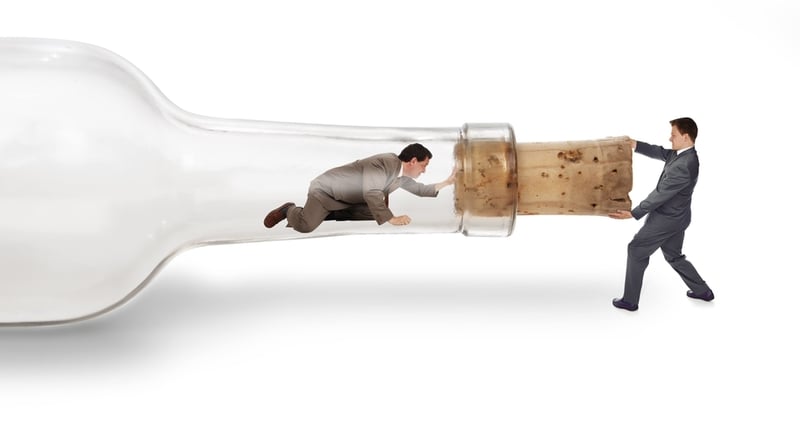Sarah’s team was facing a team productivity crisis. She was responsible for a big launch event at an upcoming trade show: colleagues to wrangle, suppliers to manage, finances to sort out, floor space to book and a thousand other things to do.
The problem? Her colleagues simply didn’t seem to share her sense of urgency. The event was six weeks away and it felt like they would never be ready in time.
Cracking the whip just hurts
She’d tried cracking the whip before, but getting nasty didn’t suit her. Half the time she felt like she was channelling Alan Sugar. The other half, David Brent. Even worse, it didn’t get the results she wanted. Sure, people bustled a bit more when she came into the room but nothing else changed.
So she started reading up on the psychology of motivation. She read Frederick Herzberg’s classic article about team productivity; Harvard Business School’s article, One More Time, How Do You Motivate Employees, and learned that a ‘kick up the arse’ doesn’t motivate. (There are other ways to encourage employee engagement.)
What creates team productivity?
This diagram by Oscar Berg is helpful for understanding more positive ways to motivate people. Is it really any surprise? Ask yourself what motivates you?

Sarah’s productivity plan
Sarah asked her mentors, colleagues and pretty much everyone else she could think of what worked for them when they had to get a lot done quickly. In a team productivity brainstorm, she identified TEN alternatives to cracking the whip and, with an experimental mindset, tried them all out.
- Standing back. As Einstein said, ‘We can’t solve problems by using the same kind of thinking we used when we created them.’ With this in mind, Sarah took a day out of the office to research, think and plan. Even though she was insanely busy, she felt it was important to take a step back to leap further forward.
- Doing something, anything. The Hawthorne effect suggests that doing almost anything can act as a spur to improved performance. Even just observing performance and trying to improve can signal your intent to change. Sarah’s team noticed that she was a woman with a plan and this made them more alert to the need to alter course.
Do something
- Listening. ‘First seek to understand, then to be understood,’ says Stephen Covey. Sarah took this advice to heart and brought her team together late on a Thursday afternoon. ‘Let’s talk about what we need to do and what’s holding us back,’ she said. It was hard not to be defensive as the team slowly began to open up about the things that they wanted to change. Sarah wrote up some powerful insights on her whiteboard and the team felt properly listened to, perhaps for the first time. The conversation continued in the pub later after work.
- Focusing. One of the biggest problems, her colleagues revealed, was a stream of requests from other parts of the business. There was a constant feeling of interruption, fire fighting and being on the back foot. Sarah’s first decision was to tell other divisions that her team was focusing on the launch, at least until everything was running smoothly. It was her top priority and she needed the rest of the business to understand this too. By doing this, she created the space her team needed to make progress.
- Measuring. If it doesn’t get measured, it doesn’t happen. Sarah worked with her colleague John, who had run a similar event the previous year, to break down the launch into smaller tasks. Together they wrote them out on index cards and blue tacked them to the office wall. Whenever someone completed one of the tasks, they got to cross it off with a round of applause from the rest of the team. At first, people were hesitant and sarcastic about it, but they soon saw the progress the team was making and ended up enjoying the recognition they received.
Stop. Collaborate and listen.
- Communicating. Sarah set up a live chat tool for her team. She looked at Slack and Microsoft Teams. More responsive and interactive than email and less disruptive than phone calls or shouting out across the room.
- Collaborating. Sarah instigated a daily ‘stand-up meeting’ for her team each morning. By making everyone stand up and contribute, she kept meetings short but massively improved the level of collaboration in the team, heading off problems before they became serious.
- Recognising the variables. It’s a truism, but with a fixed deadline, the only thing Sarah couldn’t get more of was time. Other things – budgets, staff, ambitions etc. – are all variable. Yet, the rest of the business treated them as fixed and the schedule as a variable. In other words, marketing wanted the biggest stand and the maximum impact, finance wanted to minimise the budget, salespeople wanted a quiet area on the stand for meetings with customers and so on. Everyone wanted more or less of something. Recognising this, Sarah began to invite stakeholders to a weekly meeting and presented their demands in terms of trade-offs. ‘If you want this, we need that,’ became her mantra.
Automate everything but gratitude
- Automating tedious tasks. Purchase orders were a necessary chore for Sarah’s team. They created dozens every month for suppliers, but filling out paper-based forms was not a life-affirming experience and so she decided to replace them with Turbine, an online system that automated the whole process of creating, reviewing and approving purchase orders. She also considered other options like BambooHR and
- Saying ‘thank you’. Cash bonuses and incentives sometimes have a role to play but plain recognition is an incredibly powerful (and free) motivator. With this in mind, Sarah made sure to highlight people’s contributions in meetings, share their successes with senior managers and, at the end of the project, she wrote thank you letters to the whole team. A pat on the back is always preferable to a kick in the arse.
Since this is a fable, let’s say that Sarah helped her company launch a new product with a big stand at the trade show and that everything happened on time, on budget and without stress. But what would turbocharge your team? Just hoping for a happy ending isn’t enough.





